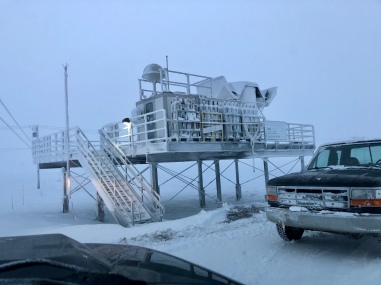
It was a strange twist of fate that Concord ended up building a relationship with a teacher who is based on the North Slope. One of the key sites for the ARM Research Facility is also located in Utqiagvik. Given the spareness of observations in the Arctic and given the key interplay between ice, ocean clouds and climate Utqiagvik is an ideal location for furthering DoE ARM’s mission of improving the understanding and representation, in climate and earth system models, of clouds and aerosols as well as their interactions and coupling with the Earth’s surface. The team at Sandia helped us work with Walter Brower, who operates the site (which is run by a native owned corporation) to arrange a site tour for myself and my education research colleagues. I have visited the ARM site in Oklahoma before, which is a sprawling complex with many staff. I was struck how Walter and one a few other people keep this key facility ship shape! One instrument I really wanted to see is the X-Band radar (X-SAPR) which I have responsibility, in my role as Translator, for maximizing the science from (through software, retrievals and helping PIs. Great to see the work the radar mentor team, led by Nitin Bharadwaj, had put into this unique instrument.

After seeing the X-SAPR Walter took us on a drive past the maintenance facilities which are located in an area run by the Ukpeagvik Inupiat Corporation where there is a college specifically designed to meet the needs of the community, and out into the great white expanse of the frozen Tundra. The site itself is a few miles out of town (on a road the team must clear and keep open themselves!). And this is the beauty of it: You have an expanse of ice, free of structures which can create issues, perfect representation of a “grid cell” of an atmospheric simulation over an expanse of ice. Perfect for testing science questions aligned with ARM’s mission. The main instrumentation is on the Great White platform, an otherworldly structure anchored in the permafrost with every instrument conceivable!

Heading to the warmth inside the Great White enclosure we saw the modern instrumentation and cyber infrastructure needed to get the massive amounts of data on the atmospheric column back to the ARM Data Center.

Walter stepped us through a number of measurements being taken over the site. Some of the most seemingly mundane but vital to the long term mission of ARM are the key components of Meteorology (which The Teacher is teaching the middle school students: Temperature, winds and moisture). ARM has a 40 meter high tower with probes at 2, 10, 20 and 40 meters so see how the atmosphere is “layered” close to the surface. As I mentioned in a previous post, the layering is completely different to the ARM site in Oklahoma due to the lack of solar heating. And that brings me to one more instrument, the balloon borne sounding! It sounds simple but is hard to achieve, attach a sensor to a balloon, let it fly through the sky, and transmit measurements back to the site via UHF. These balloons are launched at 5 and 17 UTC (8am and 8pm Local) and compliment the NWS soundings from the airport at 0 and 12 UTC and they all are used to spin up the weather simulations that are used in your local forecast.. So next time you hear about a polar outbreak on the 6 o’clock news thank, but do not blame, the ARM Research Facility in Utqiagvik! Out heartfelt thanks to Walter who took so much time to show us around and for being so generous with his local knowledge. Site operators like Walter make grand scale science in the national interest possible!
